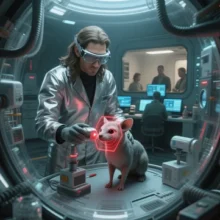
Synth mRNA (Synthetic mRNA): Innovations in Cancer Immunotherapy and Rare Disease Treatment
From Tumor Neoantigen Delivery to Defective Protein Repair
Cancer Immunotherapy: Precision Delivery of Tumor Neoantigens and Immune Activation
1. Core Technologies for Neoantigen Vaccines
- AI-Driven Antigen Screening:
- Integrates multi-omics data (exome sequencing, HLA typing, mass spectrometry) to predict tumor-specific mutations, improving neoantigen identification accuracy.
- Epitope Optimization: Molecular dynamics simulations prioritize high-affinity epitopes while excluding immunosuppressive Treg-activating epitopes.
- mRNA Vaccine Formats:
Type Features Clinical Example Peptide Vaccines 20–30 long peptides with CD4+/CD8+ epitopes Neon Therapeutics’ NEO-PV-01 + PD-1 inhibitors achieved 48% ORR in melanoma. mRNA Vaccines Encodes 34 neoantigens; dendritic cell-targeted Moderna’s mRNA-4157 + Keytruda reduced recurrence risk by 44% in Phase III trials. Viral Vector Vaccines Adenovirus/poxvirus vectors carry 60 neoantigens Nouscom’s NOUS-209 achieved 62% disease control in colorectal cancer.
2. Delivery System Breakthroughs
- Lipid Nanoparticle (LNP) Engineering:
- pH-responsive ionizable lipids (e.g., SM-102) enhance endosomal escape efficiency.
- Targeted Delivery: Antibody conjugation (e.g., anti-Dectin-1) directs LNPs to dendritic cells, reducing off-target effects.
- Alternative Carriers:
- Virus-Like Particles (VLPs): HIV Gag protein self-assembly enables lung-targeted delivery (e.g., BioNTech’s BNT161b3).
- Polymer Nanoparticles: PEG-PLA nanoparticles release mRNA responsively in tumor microenvironments.
3. Synergistic Combination Therapies
- Immune Checkpoint Inhibitors: BioNTech’s BNT111 + PD-1 inhibitors achieved 34% ORR in advanced melanoma.
- Oncolytic Viruses: HSV-1 vectors encoding IL-12 mRNA activate CD8+ T-cell infiltration in tumors.
- Radiation/Chemotherapy: mRNA vaccines combined with radiotherapy boost intratumoral T-cell ratios and reduce metastasis risk.
Rare Disease Treatment: Precision Protein Supplementation
1. Therapeutic Strategies
- Gene Defect Compensation:
- Methylmalonic Acidemia: Moderna’s mRNA-3704 encodes methylmalonyl-CoA mutase (MUT) to restore metabolic pathways in hepatocytes.
- Cystic Fibrosis: Translate Bio’s MRT-5005 delivers CFTR mRNA to lung epithelium, repairing chloride channel function (Phase II).
- Protein Replacement:
- Hemophilia: mRNA-encoded Factor IX (FIX) targets the liver via LNPs, restoring clotting function for 4 weeks post-injection.
2. Organ-Specific Delivery Systems
- Liver Targeting: GalNAc-modified LNPs leverage ASGPR receptors for 10x higher hepatocyte uptake.
- Lung Targeting: Inhalable mRNA-LNPs (<100 nm) penetrate mucus to transfect alveolar cells.
- CNS Delivery: Focused ultrasound (FUS) with microbubbles opens the blood-brain barrier for neuronal mRNA expression.
3. Clinical Challenges and Solutions
- Immunogenicity Control: Nucleoside modifications (e.g., pseudouridine, 5-methylcytidine) reduce TLR7/8 activation by 90%, extending protein expression.
- Repeat Dosing: PEGylated LNPs minimize antibody-mediated clearance, enabling monthly administration.
Shared and Divergent Design Principles
1. Shared Platforms
- mRNA Optimization:
- 5′ Cap: CleanCap AG co-transcriptional capping doubles translation efficiency.
- UTR Design: α-globin 3′ UTR extends mRNA half-life to 72 hours.
- Self-Amplifying RNA (saRNA): Alphavirus replicons prolong antigen expression to 28 days.
- Cell-Free Manufacturing: PCR-linearized DNA templates reduce production cycles to 48 hours.
2. Divergent Applications
| Aspect | Cancer Immunotherapy | Rare Disease Treatment |
|---|---|---|
| Primary Goal | Activate immune system to kill tumors | Replace/repair defective proteins |
| Delivery Target | Antigen-presenting cells (APCs) | Specific organs (liver, lung, brain) |
| Immunogenicity | Moderate innate immune activation needed | Suppress immune response to avoid interference |
| Dosing Frequency | Multi-dose regimens (3–6 cycles) | Single or low-frequency dosing |
Challenges and Future Directions
1. Technical Barriers
- Delivery Efficiency:
- DNA origami carriers enable lymph node targeting (e.g., MIT’s 90% efficiency).
- AI models predict mRNA-LNP biodistribution to optimize size and charge.
- Scalable Production: Distributed manufacturing (e.g., BioNTech’s BioNTainer) reduces costs to <$10k/dose.
2. Emerging Innovations
- Cross-Disciplinary Approaches:
- CRISPR-mRNA Therapy: Co-delivery of Cas9 mRNA and repair templates for diseases like sickle cell anemia.
- Transient CAR-T Reprogramming: mRNA-encoded CAR receptors reduce long-term toxicity risks.
- AI-Driven Design:
- Quantum computing accelerates epitope-HLA screening 100-fold (e.g., IBM).
- Generative AI designs novel capsid proteins beyond traditional directed evolution.
3. Clinical and Industry Outlook
- Cancer: 50+ Phase III candidates by 2030; off-the-shelf vaccines (e.g., KRAS G12D) to cover 5–10% of solid tumors.
- Rare Diseases: Moderna’s mRNA Access program cuts costs to <$1k/dose for low-income regions; CNS-targeted therapies (e.g., Huntington’s disease) in development.
Ethics and Safety
- Biosafety: CRISPR-based molecular barcodes track mRNA antigen evolution; HSV-TK “suicide switches” eliminate aberrant cells.
- Equity: Open-source platforms (e.g., Open Haptics Alliance) promote global access and reduce patent barriers.
Conclusion
Synth mRNA is reshaping cancer and rare disease treatment:
- Cancer Immunotherapy: Neoantigen vaccines + combination therapies boost late-stage melanoma survival rates.
- Rare Diseases: Organ-targeted delivery restores protein function in monogenic disorders.
Over the next decade, AI-driven design, biomaterials, and automation will usher in a “programmable medicine” era—from one-shot genetic fixes to off-the-shelf cancer vaccines—pushing the boundaries of precision medicine.
Data sourced from publicly available references. For collaborations or domain inquiries, contact: chuanchuan810@gmail.com.






